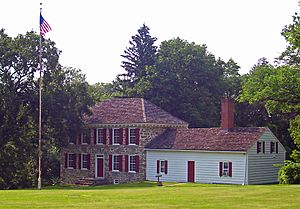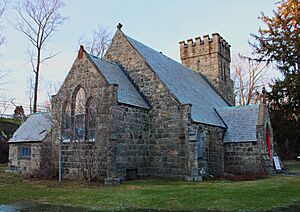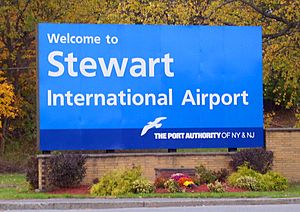New Windsor, New York facts for kids
Quick facts for kids
New Windsor, New York
|
||
|---|---|---|
| Town of New Windsor | ||
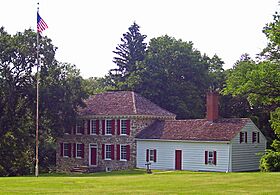
Knox's Headquarters Historic Site
|
||
|
||
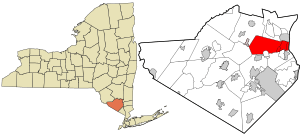
Location in Orange County and the state of New York.
|
||
| Country | ||
| State | ||
| County | Orange | |
| Founded | April 5, 1763 | |
| Founded by | General Assembly of New York | |
| Named for | Windsor, England | |
| Area | ||
| • Total | 37.06 sq mi (95.99 km2) | |
| • Land | 34.08 sq mi (88.26 km2) | |
| • Water | 2.99 sq mi (7.73 km2) | |
| Elevation | 512 ft (156 m) | |
| Population
(2020)
|
||
| • Total | 27,805 | |
| • Density | 750.27/sq mi (289.666/km2) | |
| Time zone | UTC-5 (Eastern (EST)) | |
| • Summer (DST) | UTC-4 (EDT) | |
| ZIP code |
12553
|
|
| Area code(s) | 845 | |
| FIPS code | 36-50848 | |
| GNIS feature ID | 0979274 | |
| Major airport | Stewart Airport (SWF) | |
New Windsor is a town in Orange County, New York, United States. It is home to about 27,805 people, based on the 2020 census. The town is located on the eastern side of the county, right next to the Hudson River and the City of Newburgh.
Contents
History of New Windsor
The land where New Windsor is now was first home to the Munsee people. They were part of the larger Lenape group. The first European settlers arrived in 1685. These were colonists from Scotland. The town of New Windsor was officially created on April 5, 1763.
Early European Settlements
Governor Thomas Dongan bought the land rights from the Munsee people. He wanted Scottish colonists to settle there. David Toshack and Patrick McGregorie led these settlers. They arrived in 1685. They built homes overlooking the Hudson River near Moodna Creek. McGregorie built a cabin north of the creek. Toshack set up a trading post south of the creek.
Later, Captain John Evans claimed the land in 1694. But the next governor, the Earl of Bellomont, canceled Evans's claim. This was to be fair to the settlers. In 1709, more land was given to William Chambers and William Southerland.
The name "New Windsor" comes from Windsor, England. The word "New" was added to it. This name first appeared in records in 1728. One of the first roads was the King's Highway. It was also called "the Goshen Road." Early residents like William Ellison ran a store. He also owned boats that sailed from New Windsor to New York City.
New Windsor and the Revolutionary War
During the Revolutionary War, New Windsor was very important. It served as a main supply center for the Continental Army. Most people in the town supported the war.
In October 1782, soldiers arrived in New Windsor. They built a huge camp with over 700 huts. This camp housed 6,000 to 8,000 soldiers, women, and children. They built many other buildings too, like blacksmith shops and a hospital. They also built a large meeting hall called the "Temple." This building was used for religious services and meetings.
General George Washington wanted to honor brave soldiers. He created the Badge of Military Merit. Today, this award is known as the Purple Heart. The National Purple Heart Hall of Honor is located in New Windsor. It celebrates those who received this award.
The town of New Windsor has bought 167 acres of land. This land includes many of the old hut sites from the camp. Since 1936, people have worked to protect this important historical site.
After the Revolution
The Little Britain Presbyterian Church was started by Irish and Scottish immigrants. The first church building was built in 1765. It was used as a hospital during the war. After it burned down, a new church was built in 1807.
By 1814, the town had nine school districts. The first school was a one-room schoolhouse built in 1841. Epiphany Apostolic College was founded in 1925. This site is now part of the Newburgh Enlarged City School District.
Around 1858, a company called Palmer and Longking made cameras. They had a large factory on the Quassaick Creek. This factory later became a flour mill and then burned down.
Historical Sites to Visit
- Knox's Headquarters: This old stone mansion was built in 1754. It was owned by the Ellison family. During the Revolutionary War, it was used as a headquarters for famous generals. These included Nathanael Greene, Horatio Gates, and Henry Knox.
- New Windsor Cantonment State Historic Site: This site was part of the Continental Army's last winter camp. The "Temple" building was located here. You can visit the New Windsor Cantonment today. It helps show what the army camp was like. There is also a hut there that might be from the original camp.
- Squire Patton House: This farmhouse was built in the 1790s. It shows a mix of English and Dutch building styles. These styles were common in the Hudson Valley long ago.
- Edmonston House: The Edmonston family built this stone house in 1755. It replaced an earlier log cabin. For a while, it was the only house between New Windsor and Washingtonville.
- The Thomas McDowell House: This house was built around 1770. It is located in the Little Britain area. It was added to the National Register of Historic Places in 2004.
- The Brewster House: This house was built in 1762. Samuel Brewster, who lived here, helped make the large chain. This chain was stretched across the Hudson River. It was meant to stop British ships during the war. Today, the building is a restaurant.
Churches in New Windsor
- The Vails Gate United Methodist Church started in 1789. It was the first Methodist Church in Orange County.
- St. Thomas Episcopal Church is a small stone building. It was built in 1818. It is listed on the National Register of Historic Places.
- St. Joseph Roman Catholic Church began in 1880. In 2015, it joined with another church in Cornwall-on-Hudson.
- The Ridgecrest Baptist Church started in 1962.
Geography of New Windsor
New Windsor covers about 37 square miles (95.9 square kilometers). Most of this is land, but about 2 square miles (7.73 square kilometers) is water.
The eastern edge of the town is along the Hudson River. This river forms the border with Dutchess County. Part of the northern border is with the city of Newburgh.
Interstate 87, also known as the New York State Thruway, is a major highway that runs through the town. NY-207 is another important state highway.
Communities and Locations
- Beaver Dam Lake – a small community on the southern border.
- Bulls Siding – a place between Rock Tavern and Little Britain.
- Clancyville – a community from the late 1800s. It grew around busy factories on the Quassaick Creek. Many Polish and Italian immigrants settled here.
- Denniston – a small community north of Beaverdam Lake.
- Firthcliffe Heights – a community near the Cornwall town line.
- Little Britain – a community in the western part of town. It was first settled around 1724.
- Machin's Battery – a place where cannons were set up during the Revolutionary War. This was to try and stop British ships on the Hudson River.
- Moodna – a historic spot in the town.
- Moodna Creek – also called Murderer's Creek. There's a legend about a family massacre here.
- The National Purple Heart Hall of Honor is located on Route 300.
- New Windsor - This is the main village area of the town.
- Plum Point – a park right on the Hudson River. It offers great views of the Newburgh and Cornwall bays. People have lived here since ancient times.
- Rock Tavern – a community in the western part of town. It is named after an old tavern from 1740. This tavern was built around a large boulder.
- Vails Gate – a community south of Newburgh. It was once a place where many main roads crossed. It had a toll gate for collecting fees.
- Washington Lake – a neighborhood near a small lake of the same name.
Education in New Windsor
Several school districts serve New Windsor. These include the Newburgh City School District, Washingtonville Central School District, Cornwall Central School District, and Valley Central School District (Montgomery).
Most students attend schools in Newburgh. Some areas, like Butterhill and Forest Glen, are split between Newburgh and Cornwall schools. The far southwestern part of New Windsor is served by Washingtonville schools.
Children in New Windsor go to many different schools. These include public schools like Little Britain Elementary and New Windsor School. There are also private schools like Butterhill Day School and St. Joseph School.
Transportation
Little Britain Road is one of the oldest roads in New Windsor.
Stewart International Airport is partly in New Windsor. It was once a military air force base. The airport is named after Captain Lachlan Stewart. His grandson, Thomas Archibald Stewart, helped donate land for the airport in 1930.
Stewart Airport was a military base until the 1960s or 1970s. Then it became a cargo facility. Today, Stewart International is a civilian airport. It is also home to the NY Air National Guard and the United States Marine Corps Reserve.
A new entrance to Stewart International Airport was built. This new road, New York State Route 747, connects the airport directly to major highways. This helps avoid local traffic.
Notable People from New Windsor
Many important people have connections to New Windsor:
- John Alsop (1724–1794) – Born in New Windsor, he was a delegate to the Continental Congress.
- Dr. Thomas Young (1731–1799) – Born in Little Britain, he was a member of the Boston Committee of Correspondence.
- Dr. Joseph Young (1733–1797) – Thomas's brother, also born in Little Britain. He wrote the first medical textbook in the United States.
- Col. Charles Clinton (1690–1773) – A military leader during the French and Indian War.
- Gen. James Clinton (1736–1812) – Son of Charles Clinton. He was a general in the Continental Army during the Revolutionary War. He also helped build forts in the Hudson Highlands.
- Governor George Clinton (1739–1812) – Son of Charles Clinton. He served in the Continental Congress. He was also a general, the first Governor of New York, and Vice-President of the United States.
- Governor DeWitt Clinton (1769–1828) – Son of James Clinton. He was a mayor of New York City and a New York State Senator. He is best known for helping to build the Erie Canal.
- Fletcher Mathews – A neighbor of Governor Clinton. He was allowed to stay in the country after the war because of his connection to the Governor.
- John Trumbull (1756–1843) – A famous American artist. He is known for his paintings of the American Revolutionary War. He lived in New Windsor in 1782-1783.
- Edward Payson Roe (1838–1888) – A popular novelist, minister, and gardener.
- William James Roe II (1843–1921) – A novelist, essayist, poet, and painter.
- Lee Woodward Zeigler (1868–1952) – A painter and illustrator. He created murals, including some in Newburgh.
- Rev. Charles Uncles (1859–1933) – The first Black Catholic priest to be ordained in the United States.
Industries
- ENAP is a company that sells lumber and building materials. It helps independent lumber dealers. Its main office is in New Windsor.
See also
 In Spanish: New Windsor (Nueva York) para niños
In Spanish: New Windsor (Nueva York) para niños




